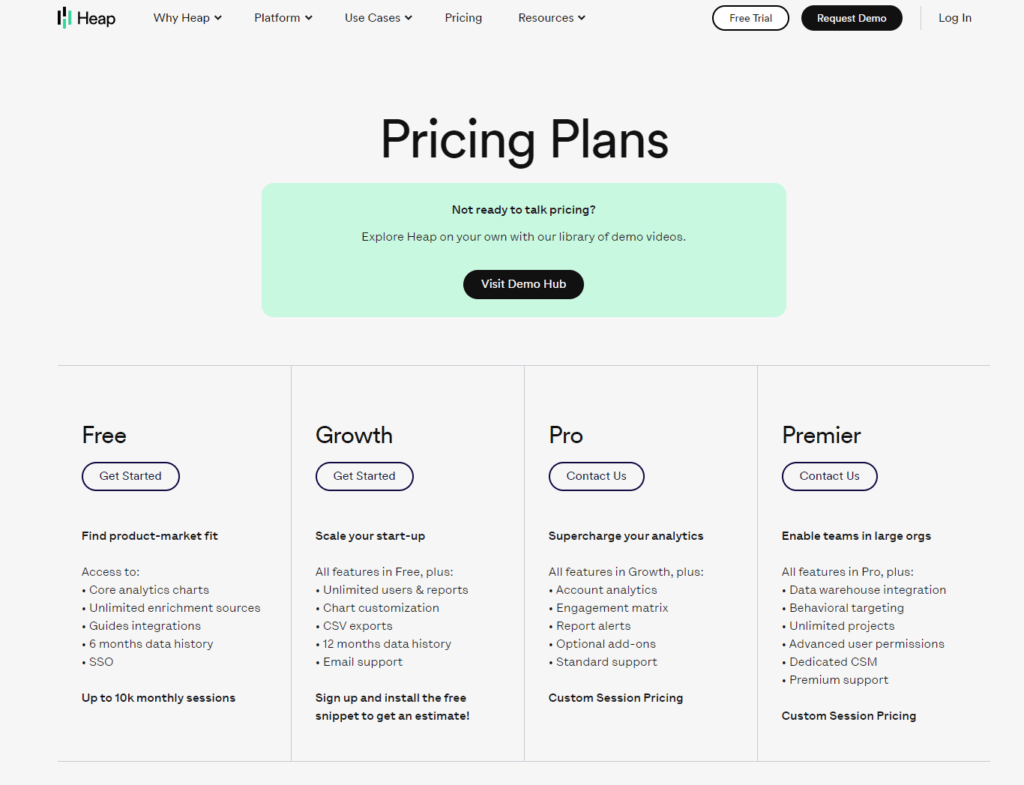In the vast and often tumultuous sea of data analytics, captains of industry and startup sailors alike are seeking the beacon that will guide their ships safely to insight shores. Two lighthouses stand tall among the mist: Oracle Analytics Cloud (OAC) and Heap. One, a formidable fortress of data analytics, promises to illuminate the path for enterprises navigating complex data oceans. The other, a nimble beacon, offers clarity and speed to agile vessels keen on understanding every wave and ripple of user interaction. But which lighthouse should you steer your ship toward? Whether you command a mighty enterprise galleon or a swift startup schooner, this guide aims to chart the waters between OAC and Heap, helping you navigate towards the analytics tool that best suits your journey.
| Oracle Analytics Cloud | Heap |
|---|---|
 |  |
| G2 Score -4.0 out of 5 | G2 Score -4.4 out of 5 |
| TrustRadius Score -8.1 out of 10 | TrustRadius Score -8.2 out of 10 |
Area of Comparison: User Interface and Accessibility
In the quest for data-driven knowledge, the ease with which you can navigate your analytics tool is as crucial as the accuracy of the insights it provides. A tool’s user interface (UI) and overall accessibility can either pave a smooth pathway to insights or entangle you in a thicket of complexity. Let’s delve into how Oracle Analytics Cloud and Heap fare on these critical fronts.
Oracle Analytics Cloud: The Vast Map Room
Oracle Analytics Cloud is akin to a grand map room in an ancient library, offering an extensive array of charts, tools, and levers designed to uncover deep insights across a broad spectrum of data landscapes. Its UI is comprehensive, catering to those who are well-versed in the language of data analytics, providing powerful capabilities for deep dives into complex datasets.
The sophistication of OAC’s interface is both its strength and its challenge. For data scientists and analysts, it’s a treasure trove of tools that offer limitless possibilities for exploration and discovery. However, for newcomers or those seeking quick insights, the complexity can be daunting. Navigating OAC’s rich functionalities requires a compass of experience, making it less accessible for casual or novice users.
Heap: Navigating With Ease
Heap, on the other hand, charts a course for simplicity and intuitiveness. Its UI is designed with the user in mind, ensuring that valuable insights are never more than a few clicks away. This focus on ease of use does not come at the expense of power; Heap provides robust analytics capabilities, particularly in tracking user interactions and behavior across digital platforms.
Heap’s interface is the agile ship in the analytics fleet, offering a streamlined and efficient way to navigate through data. It enables teams across an organization, regardless of their analytics expertise, to dive into data exploration, making it an invaluable tool for fast-paced environments where speed to insight is critical.
Pricing: Oracle Analytics Cloud vs Heap
Venturing into the realm of Pricing, we find ourselves navigating through perhaps the most pragmatic yet complex waters in our comparison journey between Oracle Analytics Cloud (OAC) and Heap. The cost of deploying these analytics platforms is a crucial consideration for any business, impacting not only immediate budget allocation but also long-term investment in data strategy. Let’s explore the pricing structures of OAC and Heap to discern which platform might offer the best value for your organization’s needs.
Oracle Analytics Cloud: The Customizable Armada

Oracle Analytics Cloud’s pricing reflects its positioning as a comprehensive, enterprise-grade analytics solution. OAC employs a subscription-based model, where the costs are tailored to the scale of deployment and the specific features and services required by the organization. This customization ensures that businesses pay for exactly what they need, but it also introduces a level of complexity into the pricing structure.
Organizations interested in OAC must navigate through various pricing tiers, each offering different levels of data processing capabilities, storage, and access to advanced analytics features. Additionally, Oracle offers add-ons and upgrades for businesses seeking to expand their analytics capabilities beyond the standard offerings. Given this variability, obtaining a clear picture of total costs requires direct consultation with Oracle’s sales team to tailor a package that suits the organization’s unique needs.
The investment in Oracle Analytics Cloud is substantial but justified for large enterprises that require a robust, scalable analytics platform capable of handling complex data environments and delivering deep insights.
Heap: The Transparent Voyager

In contrast to the customizable yet complex pricing model of OAC, Heap offers a more straightforward and transparent approach to pricing. Aimed at startups, SMEs, and digital businesses, Heap’s pricing structure is designed to be clear and predictable, with tiers based on data volume and feature access.
Heap provides several pricing plans, including a free tier for small projects or businesses just starting their analytics journey. Paid plans are structured to accommodate growing data needs and advanced features, such as greater event volumes, access to premium analysis tools, and additional team member accounts. Pricing for each tier is publicly available on Heap’s website, making it easy for potential users to understand what they’re getting and at what cost.
This transparency and simplicity make Heap an attractive option for businesses looking for a cost-effective yet powerful analytics tool that can grow with them as their data insights needs evolve.
Integration Capabilities: Oracle Analytics Cloud vs Heap
Continuing our exploration into the comparison between Oracle Analytics Cloud (OAC) and Heap, let’s venture into a domain that’s crucial for businesses looking to leverage data analytics effectively: Integration Capabilities. This aspect is the vessel that ensures smooth sailing through data streams, allowing businesses to harness a wide array of data sources and turn them into actionable insights. Let’s see how these two platforms manage the crucial task of data integration, enabling organizations to navigate the vast seas of information.
Oracle Analytics Cloud: The Majestic Galleon
Oracle Analytics Cloud stands as a majestic galleon in the world of data integration, boasting a broad and powerful set of capabilities designed to accommodate a vast array of data sources. With its enterprise roots, OAC is built to handle complex data landscapes, integrating seamlessly with various Oracle products, cloud-based data stores, on-premises databases, and third-party applications. This extensive integration capability ensures that organizations can pull in data from across their entire operation, providing a holistic view of their business landscape.
The power of OAC’s integration lies in its ability to not only gather but also to cleanse, transform, and prepare data for analysis. This ensures that data from disparate sources can be unified into a coherent whole, ready for deep analytical exploration. However, harnessing this broad range of integration capabilities can require significant technical expertise, making it more suited for organizations with dedicated data engineering resources.
Heap: The Swift Schooner
In contrast, Heap acts as a swift schooner, agile and efficient, focusing on providing deep insights into user interactions across websites and digital products. Its integration capabilities are tailored to this end, offering straightforward connections to web and mobile platforms, along with integrations with popular tools used by marketing and product teams, such as CRMs, email marketing platforms, and advertising networks.
Heap’s approach to integration is designed to be user-friendly, enabling organizations to quickly start tracking user interactions and funnel metrics without the need for extensive setup or technical intervention. This makes Heap an attractive option for startups and mid-sized businesses that may not have large data engineering teams but still wish to gain deep insights into their users’ behavior.

Related: Check out our free SEO suite

Scalability and Performance: Oracle Analytics Cloud vs Heap
Continuing our exploration between Oracle Analytics Cloud (OAC) and Heap, let’s navigate through the realms of Scalability and Performance. In the data analytics universe, the ability to scale and maintain performance under varying loads of data exploration is akin to a ship’s ability to weather storms and navigate the open seas without losing speed. This capability ensures that your analytics platform can grow with your business, adapting to increased demands without compromising on the depth and speed of insights. Let’s examine how OAC and Heap fare in these critical areas.
Oracle Analytics Cloud: The Sturdy Battleship
Oracle Analytics Cloud, with its enterprise-grade architecture, is built like a sturdy battleship, designed to withstand the high seas of big data and complex analytics without flinching. Its scalability is a testament to Oracle’s extensive experience in managing vast amounts of data and delivering high-performance computing solutions. OAC can effortlessly scale to accommodate the growing data needs of large organizations, ensuring that businesses can expand their analytics operations without worrying about hitting performance ceilings.
The platform’s performance is engineered to handle extensive datasets and complex queries, delivering insights with the speed and precision that enterprise users demand. This makes OAC an ideal solution for organizations with heavy analytics workloads that require a robust, scalable platform to support their data-driven decision-making processes. However, the sheer power and scalability of OAC come with a level of complexity and may require a dedicated team to manage and optimize the analytics infrastructure effectively.
Heap: The Agile Clipper
Heap, in contrast, takes to the seas like an agile clipper, swift and responsive, designed for speed and maneuverability. Its performance and scalability are tailored for the fast-paced world of digital product analytics, where the ability to quickly gather and analyze user interaction data is paramount. Heap excels in providing real-time insights into user behavior, ensuring that businesses can iterate rapidly on their digital products based on up-to-the-minute data.
While Heap may not match the battleship-like scalability of OAC, it offers sufficient scalability for startups, mid-sized companies, and digital businesses that require a high-performance analytics solution without the complexity of enterprise-grade platforms. Heap’s cloud-based architecture ensures that it can scale to meet the increasing data demands of its users, allowing businesses to grow their analytics capabilities in tandem with their user base.
Conclusion
Embarking on a data analytics journey is a strategic decision that impacts how an organization navigates its future. Whether you choose the robust capabilities of Oracle Analytics Cloud or the agile insights provided by Heap, the key to success lies in leveraging the selected tool to its fullest potential, ensuring it aligns with your strategic objectives and empowers your team to make data-driven decisions.
READ NEXT:
- Oracle Analytics Cloud vs Mixpanel: The Best Analytics Tool for You
- Oracle Analytics Cloud vs MonsterInsights: The Best Analytics Tool for You
- Oracle Analytics Cloud vs Baremetrics: The Best Analytics Tool for You
- MicroStrategy vs Kissmetrics: The Best Analytics Tool for You
- Bitrix24 vs Vtiger: The Best CRM Tool for You
- 11 Marketing Analytics Tools to Elevate Your Data-Driven Strategies
- 29+ Digital Analytics Software to Skyrocket Your Digital ROI






















Comments are closed.